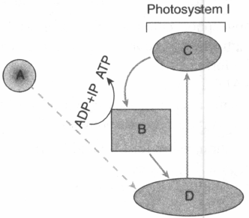Photochemical Phase of Photosynthesis
Photochemical Phase of Photosynthesis: Overview
This Topic covers sub-topics such as Noncyclic Photophosphorylation, Chemiosmotic Hypothesis, Cyclic Photophosphorylation, Photo Phosphorylation, Cytochrome, Absorption Spectrum, Nicotinamide Adenine Dinucleotide Phosphate, Light Reaction and, ATP Synthase
Important Questions on Photochemical Phase of Photosynthesis
Through the use of oxygen-18 (heavy oxygen), scientists have found that the oxygen released during photosynthesis comes from molecules of:
Which one of the following categories of organisms do not evolve oxygen during photosynthesis?
Hill reaction occurs in
The specific functionof light energy in the process of photosynthesis is to:
Which of the following combinations is required for chemiosmosis?
The reaction centre in PS II has an absorption maxima at
A lower value of pH is maintained in the lumen of thylakoid of chloroplasts is due to:
I. Movement of protons across the membrane through CF0 channel.
II. Release of protons by proton carrier into the lumen.
III. Oxidation of water molecule.
IV. Reduction of NADP+ towards stroma.
Replenishment of electrons in PS-II is mainly done by:
The chlorophyll molecule in reaction centre of PS II has maximum absorption at:
Unidirectional flow of electrons in photophosphorylation takes place in
We can observe the scheme during movement of electrons in –
What is the relationship between fixation and incident light at low intensities?
Which of the following chlorophyll type ejects the electron during photophosphorylation?
Identify A to D in the given figure.

The process for which manganese and chloride ions are required is
Identify A to D in the given figure.

In light reaction of photosynthesis, chlorophyll is subjected to
Which type of phosphorylation takes place in photosynthesis?
Chemiosmosis requires
Which of the following acts as a transmembrane channel?
